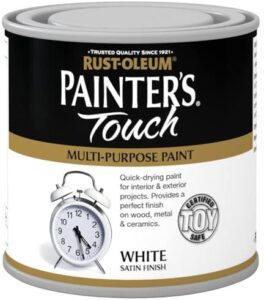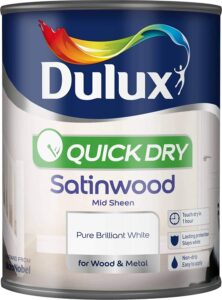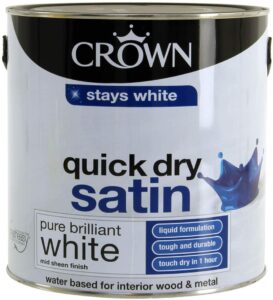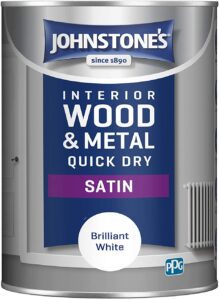
Are you looking to brighten up some of the most-used areas of the home? One of the quickest and easiest ways to brighten up all over the home, instead of just focusing on one singular room, is to address the internal doors. While walls are instrumental in carrying a room’s aesthetic, doors naturally play their own distinct part because they are the connectors between rooms.
Interior doors can be painted a myriad of different colours, though sometimes it’s hard to overlook a clean, bright white to encourage the sense of more light and space into any room, regardless of size and natural light levels.
Interior doors are subject to constant everyday wear and tear, so the internal door paint must be tough enough to stand up to such frequent us and abuse. A poor-quality paint may fade over time, or specifically for white doors, they may yellow. This will leave your woodwork looking tired and out-dated. And those are just a couple of the considerations – that’s what our guide here is for. Read on for our selection of the best interior door paints available to you to buy today.
| Name | Coverage | Dry Time | Cost |
|---|---|---|---|
| Rust-Oleum Painter’s Touch | 6 m2 /l | 2 hours | £££ |
| Rustins Small Job Satin Paint | 12 m2 /l | 0.5 hours | £ |
| Dulux Quick Dry Satinwood | 12 m2 /l | 6 hours | ££ |
| Crown Quick Dry Satin | 16 m2 /l | 1 hours | ££ |
| Johnstone’s Quick Dry Satin | 12 m2 /l | 2 hours | £ |
Rust-Oleum Painter’s Touch
The seven vibrant and bold colourways in the Painter’s Touch range from Rust-Oleum, which comprises both gloss and satin finishes, represent a great choice for the application of painting interior doors. It strikes a remarkable balance between being a specialist paint and being a very versatile paint, proving its worth on multiple applications as well as door.
Wood is where it figuratively, and literally, shines however. getting a perfect finish on all parts of the door is easy, and just needs a light and careful hand with the brush, roller or both. It takes a mere 2 hours to dry enough to be ready for another coat, if one is needed at all. Regardless, it will still be touch dry in around an hour, so the painted doors don’t have to stay off-limits for long. The smaller tin doesn’t necessarily represetn the best value, but it more than makes up for it in quality.
Pros
- High quality
- Versatile
- Good colour options
Cons
- Middling value
Rustins Small Job Satin Paint
Looking to bring a vibrant burst of colour into your interior door DIY project? British-based brand Rustins have got yoiu covered with their Small Job paint range. An excellent value choice for bringing a vibrant pop of colour into any furniture decoration project, it’s available in 6 bold and vivid shades (for the satin finish, other finishes available).
Thanks to a water-based formula, it’s a very quick drying paint with it becoming touch dry after just 30 minutes. Additionally, it’s low-odour, and is ultimately very hard-wearing – perfect for something that experiences as much traffic as doors do. Rustins also highlight how the paint meets safety standards for toys, so it’s a good choice if you have younger children around the house.
Pros
- Great value
- Colour options
- Low odour
- Safety standards
Cons
- Colours quite bright
Dulux Quick Dry Satinwood
Dulux’s range of quick-drying satin paint has been designed squarely with the aim of making household painting a hassle-free experience. It dries to a gorgeous mid sheen, half way between matt and glossy finishes, which brings bright and bold colour to your doors. The paint is also touch dry in just one hour and fully dry in 6 thanks to a water-based formula.
A couple of coats might be necessary for the brightest white, but the effort is worth it with the quality of finish you’d expect from Dulux. Add in low odour levels as well as the short drying times, and this becomes very easy to work with. On top of that it’s non-drip for even greater ease of use, and is exceptionally durable to keep the beautiful white finish free from yellowing for longer. It’s also straightforward to just wipe clean, with the inevitable marks from hands on and around the doors.
Pros
- Quick to dry
- Excellent finish
- Durable
- Easy to use
Cons
- Limited colours
Crown Quick Dry Satin
Crown’s quick-drying Satin is a great choice for a good value, durable paint with a great lasting finish. Once dry, the colour is a bold and bright white with a mid sheen satin finish, perfect for encouraging extra light into a room or hallway. It’s resistant to yellowing to keep it looking brighter for longer, and can also be wiped clean with a damp cloth.
It’s also been formulate by Crown to be exceptionally low-odour – it’s a water-based paint that is completely free of solvents. As it’s water-based, it’s dry to the touch in around an hour, and needs 6 hours between coats if more than one is necessary. Coming as standard in a 2.5 litre tin also makes it very good value for money, that when paired with the other great features, makes it hard to beat.
Pros
- Great finish
- Good value
- Quick drying
- Low odour
Cons
- Needs diluting before use
Johnstone’s Quick Dry Satin
Johnstone’s interior-specific satin paint is offered in a selection of 10 different hues ranging from lights to darks via creams and pinks, meaning that there’s bound to be a shade out there that perfectly complements your household aesthetic. The satin finish, sitting neatly in the middle between matt and gloss, is bold and hard-wearing. This is especially important for doors, as such high traffic surfaces in the home.
Johnstone’s paint is touch dry in only around 2 hours, thanks in no small part to being a water-based paint. This water base also ensures that the paint remains very low odour and additionally super simple to just wipe clean. Naturally, then, this means that your doors are going to be looking their best for a very long time, saving you time in re-coating them down the line. Johnstone’s are also notable for their value for money; this paint comes in at 1.25 and 2.5 litre volumes for a very competitive price.
Pros
- Quick drying
- Easy to use
- Long-lasting
- Great finish
Cons
- Fairly thin
Which Internal Door Paint To Go For?
When you’re re-decorating, painting your internal doors can be a huge part of carrying a design or aesthetic seamlessly from one room to another. That’s why it’s vital to get the right paint for the job. Here, we’ve summarised the all-round best paint for your interior doors, as well as the best value option as well.
Best Interior Door Paint – Overall, the Dulux Quick Dry Satinwood represents the best overall quality of paint. White is a classic colour for most doors, and this particular white finish is exceptional. While it’s not necessarily the quickest to dry, the eventual finished product will be well worth the wait.
Best Value – Out of everything, Johnstone’s Quick Dry Interior Wood and Metal stands out as the best value interior door paint. It manages to hold a great balance between great quality paint that comes in large volumes and lots of colour options, all with a very low initial investment. It’s hard to argue that you get lots for your money here.
Internal Door Paint FAQ
How to paint an internal door
Painting interior doors couldn’t be simpler. For best results, things need to be done in a more specific order. Start with the edges, then the mouldings and panels, using the edge of the brush for recessed bits. On the flatter surfaces, use the flat of the brush going left, right, up and down for the most even spread of paint.
How to paint an interior door without removing it
Follow the above steps, with the added preparatory stage of simply wedging it half-open to allow you access to all the sides, as well as encouraging ventilation. Then, follow the usual steps.
How to paint an internal door without brush marks
If you’re using a brush, the easiest way to minimise and avoid brush marks is to use long, even brush strokes going left to right, then up to down. However, an even more fail safe method to guarantee no brush marks is to use a roller, ensuring that you evenly coat the roller (and the door) throughout.





